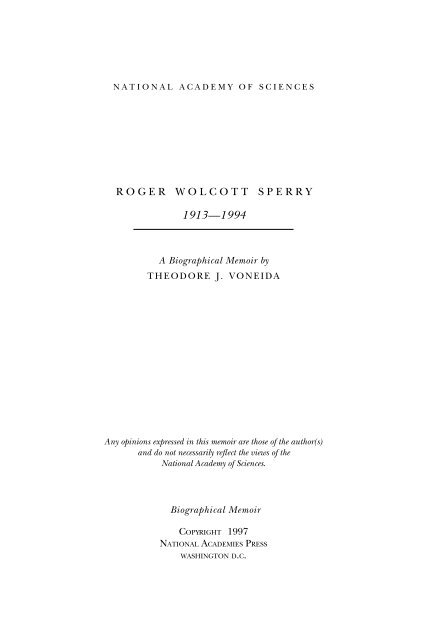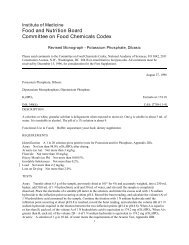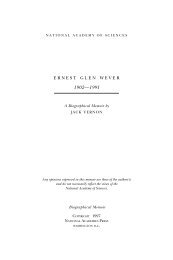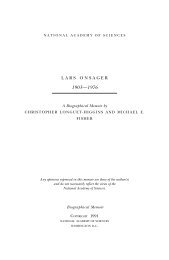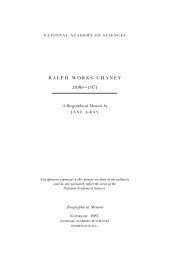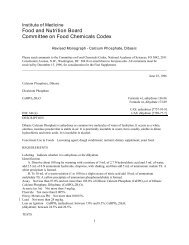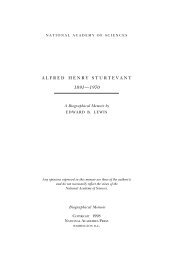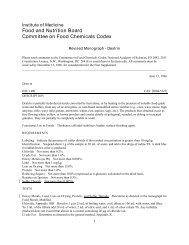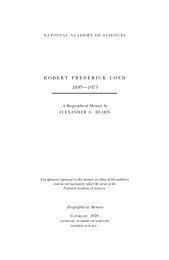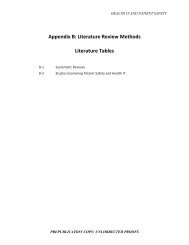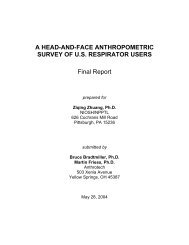ROGER WOLCOTT SPERRY - The National Academies Press
ROGER WOLCOTT SPERRY - The National Academies Press
ROGER WOLCOTT SPERRY - The National Academies Press
Create successful ePaper yourself
Turn your PDF publications into a flip-book with our unique Google optimized e-Paper software.
n a t i o n a l a c a d e m y o f s c i e n c e s<br />
R o g e r W o l c o t t S p e r r y<br />
1913—1994<br />
A Biographical Memoir by<br />
T h e o d o r e J . V o n e i d a<br />
Any opinions expressed in this memoir are those of the author(s)<br />
and do not necessarily reflect the views of the<br />
<strong>National</strong> Academy of Sciences.<br />
Biographical Memoir<br />
Copyright 1997<br />
<strong>National</strong> <strong>Academies</strong> <strong>Press</strong><br />
washington d.c.
Photo by Lois MacBird; courtesy of the California Institute of Technology
<strong>ROGER</strong> <strong>WOLCOTT</strong> <strong>SPERRY</strong><br />
August 20, 1913–April 17, 1994<br />
BY THEODORE J. VONEIDA<br />
“W<br />
HERE DOES behavior come from? What is the purpose<br />
of consciousness?”<br />
Questions such as these, which appeared on the first page<br />
of Sperry’s class notes in a freshman psychology course at<br />
Oberlin College, represent an accurate preview of a career<br />
that included major contributions to fundamental issues in<br />
neurobiology, psychology, and philosophy. Indeed, his first<br />
paper, published in the Journal of General Psychology in 1939,<br />
entitled “Action Current Study in Movement Coordination,”<br />
begins: “<strong>The</strong> objective psychologist, hoping to get at the<br />
physiological side of behavior, is apt to plunge immediately<br />
into neurology trying to correlate brain activity with modes<br />
of experience,” and continues, setting the stage for much<br />
that was to follow: “<strong>The</strong> result in many cases only accentuates<br />
the gap between the total experience as studied by the<br />
psychologist and neural activity as analyzed by the neurologist.”<br />
Roger Sperry was born in Hartford, Connecticut, and<br />
spent his early years on a nearby farm, where he developed<br />
a lifelong interest in nature. After the death of his father,<br />
the family moved to West Hartford, where he attended high<br />
school and established an all-state record in the javelin throw.<br />
315
316 BIOGRAPHICAL MEMOIRS<br />
Sperry was accepted to Oberlin College under a full academic<br />
scholarship, earning his board by waiting tables. He<br />
maintained an active interest in sports and was elected captain<br />
of the varsity basketball team, while receiving varsity<br />
letters as well in baseball and track. As an undergraduate<br />
he attended R. H. Stetson’s course, “Introduction to Psychology.”<br />
It was during a lecture by Stetson in this course<br />
that Sperry got the idea for a paper he published some<br />
twenty years later entitled “On the Neural Basis of the Conditioned<br />
Response” (1955). This short paper carries powerful<br />
theoretical implications for those interested in central<br />
nervous pathways in conditioned learning. Sperry remained<br />
at Oberlin College, in Stetson’s laboratory, through 1937,<br />
when he received his M.A. in psychology.<br />
Sperry took his Ph.D. in Zoology from the University of<br />
Chicago in 1941, under the tutelage of the renowned neuroscientist<br />
Paul Weiss. During that period, in addition to<br />
developing highly skilled neurosurgical techniques, he made<br />
the first of what was to become a number of successful<br />
challenges to existing concepts related to neuronal specificity<br />
and brain circuitry. In a series of carefully controlled<br />
and clearly written publications between 1941 and 1946,<br />
Sperry conclusively demonstrated that the rat’s motor system<br />
was “hard wired” and unmodifiable (following transplants)<br />
by training. This work clearly established that the<br />
basic circuitry of the mammalian central nervous system is<br />
largely hard wired for specific functions and seriously challenged<br />
Weiss’s “resonance principle” and “impulse specificity<br />
theory.”<br />
<strong>The</strong>se studies were to have an impact on human neurosurgery<br />
as well. From 1942 to 1945, during his military service<br />
with the Office of Scientific Research and Development,<br />
Nerve Injury Project, Sperry’s work, along with that<br />
of Weiss and others, resulted in a major change in the sur-
<strong>ROGER</strong> <strong>WOLCOTT</strong> <strong>SPERRY</strong><br />
317<br />
gical management of nerve-damaged soldiers. It was common<br />
practice until that time to surgically transplant nerves<br />
to antagonistic muscle groups and then to subject the recipient<br />
to intense retraining, with the goal of regaining<br />
normal function. <strong>The</strong> demonstration that the basic structure<br />
of the mammalian central nervous system is hard wired,<br />
and unmodifiable by training, resulted in significant modifications<br />
of treatment protocols.<br />
During Sperry’s postdoctoral years with Karl S. Lashley at<br />
Harvard and at the Yerkes Laboratories of Primate Biology<br />
in Orange Park, Florida, he continued the work on neuronal<br />
specificity that he had begun as a doctoral student<br />
and initiated a new series of studies on the role of electrical<br />
fields in neocortical functioning. It was also during this<br />
period that he performed a series of brilliant experiments<br />
involving the rotation of eyes in amphibians. <strong>The</strong> optic nerves<br />
were sectioned and the eyes rotated 180 degrees. <strong>The</strong> question<br />
was whether vision would be normal after regeneration<br />
or would the animal forever view the world as “upside<br />
down” and right-left reversed. Should the latter prove to be<br />
the case, it would mean that the nerves were somehow<br />
“guided” back to their original sites of termination. Restoration<br />
of normal vision (i.e., “seeing” the world in a “rightside-up”<br />
orientation) would mean that the regenerating<br />
nerves had terminated in new sites, quite different from the<br />
original ones. <strong>The</strong> answer was unequivocal. <strong>The</strong> animals<br />
reacted as though the world was upside down and reversed<br />
from right to left. Furthermore, no amount of training could<br />
change the response. <strong>The</strong>se studies, which provided strong<br />
evidence for nerve guidance by “intricate chemical codes<br />
under genetic control” (1963) culminated in Sperry’s chemoaffinity<br />
theory (1951).<br />
Sperry later confirmed anatomically his behavioral studies<br />
with amphibia in a series of papers published between
318 BIOGRAPHICAL MEMOIRS<br />
1952 and 1964, on nerve-muscle and retino-tectal regeneration<br />
in fish. <strong>The</strong>se experiments laid the foundation for many<br />
of our present-day views about neuronal specificity in brain<br />
development. While a number of recent studies have challenged<br />
the chemoaffinity theory, it still stands as “one of<br />
the most profound insights in developmental neurobiology. 1<br />
Thus, through an ingenious combination of behavioral and<br />
anatomic approaches, Sperry related the functional interconnection<br />
of neuronal elements to developmental principles<br />
of differentiation, cellular interaction, cytochemistry,<br />
and genetics. It was primarily this work, begun as a predoctoral<br />
student in 1938 and pursued through the early<br />
1960s that led to his election to the <strong>National</strong> Academy of<br />
Sciences in 1960.<br />
Sperry’s reason for choosing Lashley as a postdoctoral<br />
mentor is not entirely clear, but reflects his interest in<br />
Lashley’s principle of equipotentiality. Sperry was uncomfortable<br />
with the idea that electrical fields or waves acting<br />
in a volume conductor were critical for neocortical processing.<br />
His first study to challenge this concept was published<br />
in 1947. Here he demonstrated that motor coordination in<br />
monkeys remained virtually unaffected after multiple<br />
transections of sensorimotor cortex. Later, in a series of<br />
papers with Miner, Myers, and Zartman, he confirmed this<br />
point by demonstrating that neither subpial slicing, the insertion<br />
of numerous short-circuiting tantalum wires, or insulating<br />
mica plates into the cortex had any adverse effect<br />
on cortical function. <strong>The</strong>se studies demonstrated that perception<br />
depends on vertically oriented afferent and efferent<br />
cortical axons, predating Mountcastle’s discovery of vertically<br />
oriented cortical columns. Sperry’s premise was based<br />
on his keen understanding of neuroanatomy and neurophysiology,<br />
including the work of Santiago Ramon y Cajal<br />
and Lorente de Nó, both of whom had demonstrated the
<strong>ROGER</strong> <strong>WOLCOTT</strong> <strong>SPERRY</strong><br />
319<br />
importance of radial cortical connections to cortical function.<br />
In these few carefully conducted experiments, Sperry<br />
once again upset two major theories of brain function—the<br />
gestalt electric field theory of perception and the reduplicated<br />
interference pattern hypothesis. Indeed, when the<br />
renowned neuroembryologist Viktor Hamburger presented<br />
Sperry with the Ralph Gerard Award from the Society of<br />
Neuroscience in 1979, he proclaimed: “I know of nobody<br />
else who has disposed of cherished ideas of both his doctoral<br />
and his postdoctoral sponsor, both at that time the<br />
acknowledged leaders in their fields.”<br />
It was during this postdoctoral period that Sperry began<br />
thinking about the functions of the corpus callosum.<br />
<strong>The</strong> function of this “great cerebral commissure,” which<br />
represents the major set of connections between the two<br />
cerebral hemispheres, had remained a mystery to neurobiologists.<br />
Some even joked about it, possibly out of embarrassment,<br />
for very little was known of its function at the<br />
time. Lashley, for example, is said to have remarked that its<br />
major function may be to mediate epileptic seizure activity<br />
from one hemisphere to the other; Warren McCulloch<br />
quipped that it may simply be there to keep the two hemispheres<br />
from falling into each other. <strong>The</strong> mystery of the<br />
corpus callosum continued to absorb Sperry, and shortly<br />
after moving to the Department of Anatomy at the University<br />
of Chicago in 1946, he began to examine this problem.<br />
Sperry remained at Chicago through 1953, during which<br />
time several momentous events took place in his life. On<br />
December 28, 1949, he and Norma Deupree were married<br />
in Wichita, Kansas. Norma was to become his lifelong collaborator<br />
and mother of two children, Glenn Tad and Jan<br />
Hope. In 1949 Sperry contracted tuberculosis from a monkey<br />
he had been dissecting in order to obtain tissues for<br />
nerve transplants. <strong>The</strong> diagnosis was made during a rou-
320 BIOGRAPHICAL MEMOIRS<br />
tine physical examination, the initial results of which declared<br />
him in excellent health (Norma Sperry, personal<br />
communication, 1995). Chest X rays and further tests, however,<br />
confirmed the diagnosis, and the Sperrys began a sabbatical<br />
leave at Saranac Lake in upstate New York, for a<br />
period of rest and recovery. Norma relates that while there<br />
was very little rest, there was a great deal of fishing, swimming,<br />
hiking, and writing. In six months Sperry was given a<br />
clean bill of health, and he and Norma spent the remainder<br />
of his sabbatical year at the Marine Biology Laboratory<br />
in Coral Gables, Florida.<br />
Sperry returned to Chicago and became associate professor<br />
of psychology in 1952, a position he held concurrently<br />
with his position as section chief of neurological diseases<br />
and blindness at the <strong>National</strong> Institutes of Health. <strong>The</strong> first<br />
published description of his studies on callosal function<br />
appeared as an abstract in 1953, in collaboration with his<br />
doctoral student, Ronald Myers. Plans to move to Bethesda,<br />
Maryland, were postponed by a delay in building construction<br />
at NIH, during which time Sperry was offered the prestigious<br />
Hixon Professorship of Psychobiology at the California<br />
Institute of Technology, a position he began in 1954.<br />
During the next four decades, a very large number of<br />
students and visiting scholars were to study in Sperry’s laboratory.<br />
I first met Roger during the summer of 1958, when I<br />
spent several months with him as a visiting graduate student<br />
from Professor Marcus Singer’s laboratory at Cornell.<br />
Singer and Sperry generously shared the cost of my visit,<br />
and I was able to take my wife and young daughter along<br />
for a summer that was to have a profound effect on my<br />
career. Sperry was, among other things, an outstanding neuroanatomist,<br />
and we hit it off immediately. My work on<br />
central nervous substrates of conditioned learning began<br />
during the summer of 1958 and continued in his labora-
<strong>ROGER</strong> <strong>WOLCOTT</strong> <strong>SPERRY</strong><br />
321<br />
tory through September 1962. My work continues to this<br />
day and remains strongly influenced by the impact of Sperry’s<br />
thinking.<br />
Sperry was a great teacher, but not in the conventional<br />
method of lecturing to students about factual material. His<br />
style involved one-on-one discussions, exchanging ideas, and<br />
providing insightful critiques of proposals. He once told<br />
me, during a discussion about a research idea, that I should<br />
“write it up, as if you have completed the study.” I was<br />
rather surprised by this, but he went on to explain that by<br />
writing the Introduction, I would be forced to not only<br />
critically review the literature but also consolidate my ideas.<br />
“Materials and Methods” would tell me exactly what I would<br />
need to carry it out, and “you pretty well know that the<br />
results will turn out one way or another, so you should<br />
write it up both ways.” “Finally,” he said “the Discussion<br />
section will assist you in critiquing your results, whatever<br />
they are. By the time you get that done, you will know<br />
whether it’s worthwhile to embark upon the study.” <strong>The</strong>n<br />
he said with a broad grin: “And you will already have the<br />
paper written.”<br />
Sperry’s laboratory in the Division of Biology at Caltech<br />
also became a center for many new studies on nerve regeneration<br />
in fish and amphibia, reinforcing his earlier work<br />
on chemoaffinity and genetic control as major factors in<br />
neural development. His interests in learning began to take<br />
full form during the early years of this period, and in 1955<br />
he published a short provocative paper on the nature of<br />
the conditioned response, in which he emphasized the role<br />
of transitory facilitatory motor sets and “perceptual expectancy”<br />
that continues to have a profound effect on work in<br />
this area. It was also at Caltech where Sperry began to develop,<br />
along with a growing number of graduate students,<br />
postdoctoral fellows, and visiting scientists, his “split-brain”
322 BIOGRAPHICAL MEMOIRS<br />
experiments, in which the two brain halves are separated<br />
by midline section of forebrain and midbrain commissues.<br />
<strong>The</strong>se studies elegantly elucidated some of the major functions<br />
of the corpus callosum in interhemispheric memory<br />
transfer and eye-hand coordination. Restriction of sensory<br />
input to one brain half in commissurotomized animals was<br />
shown to limit the learning of various tasks to that hemisphere;<br />
the opposite side was capable of learning but remained<br />
naive to those tasks until trained. Learning curves<br />
for each hemisphere were virtually identical; it was as if two<br />
separate brains were housed within a single cranial vault.<br />
A large number of experiments were carried out by Sperry<br />
and his students during the late 1950s and early 1960s, all<br />
based on the possibilities suggested by the split-brain preparation.<br />
Sperry was very generous about sharing authorship.<br />
He insisted on being second or third author on much of<br />
the work published with his students. When I once suggested<br />
that he should be first author on a study that we had<br />
worked on together, he said he would prefer that I be sole<br />
author, but if I felt that it might help to have his name on<br />
the paper, he would be second author. I remained sole author<br />
on most of the work I performed in his laboratory<br />
because Sperry felt that it would help my own career more<br />
that way. This was very typical of his attitude toward authorship<br />
when he felt that another had done the bulk of the<br />
work in the area, even though he had made important contributions<br />
to it. He was a fair and generous person in all of<br />
his interactions with others.<br />
In 1960 Dr. Joseph Bogen, who had been doing research<br />
in the Biology Division at Caltech, suggested that the splitbrain<br />
work might be extended to humans because earlier<br />
studies by Van Wagenen, Akelitis, and others had suggested<br />
that commissurotomy was efficacious in the treatment of<br />
epilepsy. Commissurotomy was known to have little effect
<strong>ROGER</strong> <strong>WOLCOTT</strong> <strong>SPERRY</strong><br />
323<br />
on general levels of intelligence and motor coordination,<br />
and it was felt that this operation might not only reduce<br />
seizures but also prevent their propagation, with little or no<br />
severe side effects. <strong>The</strong> opportunity arose in 1962, when a<br />
World War II veteran with progressively worsening seizures<br />
(up to twenty per day), underwent a callosalectomy by Drs.<br />
Philip Vogel and Joseph Bogen. <strong>The</strong> operation was successful,<br />
and there was a dramatic reduction in the number and<br />
severity of the patient’s seizures.<br />
Sperry, along with Bogen and Sperry’s graduate students,<br />
Colwyn Trevarthen and Michael Gazzaniga, then began a<br />
series of tests directed at understanding the effects of<br />
commissurotomy on human perception, speech, and motor<br />
control. <strong>The</strong> work on humans allowed investigators to compare<br />
cognitive abilities between the two separated brain halves,<br />
demonstrating differences theretofore unrecognized. <strong>The</strong><br />
left brain half, for example, was found to be superior to the<br />
right in tasks involving analytical, sequential, and linguistic<br />
processing; the right performed better in wholistic, parallel,<br />
and spatial abilities.<br />
For the next twenty years the work of Sperry and his<br />
collaborators revolutionized our understanding of brain function.<br />
<strong>The</strong>y elucidated the unique capabilities of each hemisphere<br />
and demonstrated that the combined effect of bihemispheric<br />
activity amounted to more than the simple<br />
additive effects of the two separate hemispheres. Sperry’s<br />
brilliant studies on the functional specialization of the cerebral<br />
hemispheres won him a share of the 1981 Nobel<br />
prize for physiology or medicine.<br />
Far from resting on his laurels, Sperry left others to continue<br />
the examination of right-hemisphere/left-hemisphere<br />
functions and moved forward to explore the emergence of<br />
consciousness from the unified brain. His first major paper<br />
on the topic of the mind and consciousness appeared in
324 BIOGRAPHICAL MEMOIRS<br />
1965 and was only the beginning of many more to follow<br />
over the next thirty years. He had actually broached this<br />
issue as early as 1959 as part of a discussion at a Josiah Macy<br />
conference on the central nervous system and behavior,<br />
where he stated:<br />
I have never been entirely satisfied with the materialistic or behavioristic<br />
thesis that a complete explanation of brain function is possible in purely<br />
objective terms with no reference whatever to subjective experience; i.e.,<br />
that in scientific analysis we can confidently and advantageously disregard<br />
the subjective properties of the brain process. I do not mean we should<br />
abandon the objective approach or repeat the errors of the earlier introspective<br />
era. It is just that I find it difficult to believe that the sensations<br />
and other subjective experiences per se serve no function, have no operational<br />
value and no place in our working models of the brain.<br />
In his 1965 paper entitled “Mind, Brain and Humanist<br />
Values,” Sperry proposed that subjective experience plays a<br />
principal role in brain function. He posited that behaviorism<br />
and reductionism must both be replaced by a new concept<br />
of consciousness, based on the ideas of emergence<br />
and downward causation. <strong>The</strong> concept of emergence, according<br />
to Sperry, “occurs whenever the interaction between<br />
2 or more entities, be they subparticles, atoms or molecules,<br />
creates a new entity with new laws and properties formerly<br />
nonexistent in the universe.” He notes the parallel with<br />
quantum physics in which “interactions among subatomic<br />
particles result in emergent properties which in no way resemble<br />
the particles from which they arose.” It is important<br />
to emphasize that Sperry did not see this as dualism, which<br />
treats the mind as a separate entity outside the brain that is<br />
capable of existing independently of it. Nor did he accept<br />
the term “psychophysical interaction,” suggested by Popper<br />
and Eccles in 1977. Sperry pointed out in “Holding Course<br />
Amid Shifting Paradigms” (1994) that the erroneous classification<br />
of this conception is probably based on an earlier
<strong>ROGER</strong> <strong>WOLCOTT</strong> <strong>SPERRY</strong><br />
325<br />
terminology in which “mentalism” was equated with dualism.<br />
He describes his reasons for retaining the term mentalism<br />
in preference to Bunge’s (1977) “emergent materialism”<br />
or Natsoulas’s (1987) “physical monism,” emphasizing<br />
that this new form of mentalism must be viewed as a “quite<br />
different intermediate position which is monistic, not dualistic.”<br />
Thus, consciousness, in Sperry’s view, while generated by<br />
and dependent on neural activity, is nonetheless separate<br />
from it. Consciousness emerges from the activity of cerebral<br />
networks as an independent entity. This newly emerged<br />
property, which we call “mind” or “consciousness,” continually<br />
feeds back to the central nervous system, resulting in a<br />
highly dynamic process of emergence, feedback (downward<br />
causation), newly emergent states, further feedback, and so<br />
forth. Reducing consciousness to its separate components<br />
obliterates the emergent phenomenon of “mind” with all<br />
its great power and uniqueness.<br />
Sperry elevated this concept of emergence from the individual<br />
to the global level, stating that “the new paradigm<br />
affirms that the world we live in is driven not solely by<br />
mindless physical forces but, more crucially, by subjective<br />
human values. Human values become the underlying key to<br />
world change” (1972). He contended that this view, integrating<br />
macro- and microdeterminism with the causal reality<br />
of mental states is a more valid foundation for all science,<br />
not just psychology, with “endless humanistic<br />
implications for philosophy, religion and human values<br />
(1993). By introducing the issue of human values, Sperry<br />
moved beyond the specifics of mind and consciousness to<br />
urge that these very unique and powerful forces be directed<br />
toward improving and preserving the quality of life on our<br />
planet, rather than the reverse. He made a strong appeal,<br />
especially to his scientific colleagues, to turn their efforts
326 BIOGRAPHICAL MEMOIRS<br />
toward these goals. His message began, finally, to be heard<br />
by the scientific community. In response, and under the<br />
able leadership of his long-term friend and colleague, Dr.<br />
Rita Levi-Montalcini, an international conference was convened<br />
at the University of Trieste in November 1992 to<br />
discuss these ideas in greater detail. <strong>The</strong> plan was to work<br />
toward the creation of a strong statement of human duties,<br />
generated by the scientific community, but speaking to every<br />
“mind” willing to listen. This might represent a corollary<br />
to the United Nations’s Declaration of Human Rights.<br />
<strong>The</strong> first meeting of the group, which, unfortunately, Sperry<br />
was not able to attend, included ten Nobel laureates and<br />
numerous others, representing such widespread disciplines<br />
as neurobiology, chemistry, physics, economics, and theology.<br />
After much discussion, a draft version of “<strong>The</strong> Magna<br />
Carta of Human Duties” was generated, with an agreement<br />
to continue discussion the following year. In November 1993<br />
a near-final draft was completed, and after circulation to all<br />
participating members for ratification, the final version,<br />
entitled, “A Declaration of Human Duties,” was agreed on<br />
in 1994. <strong>The</strong> document was forwarded to the United Nations,<br />
where it is presently under review and consideration.<br />
A second series of conferences inspired by Sperry’s ideas<br />
on the mind and human values was organized by Professor<br />
Kaoro Yamaguchi. <strong>The</strong> long-term goal of these conferences<br />
(there have been four to date), held on the island of Awaji,<br />
is to work toward establishing an International Network<br />
University of the Green World, dedicated to the continuing<br />
study of human values.<br />
Sperry’s thinking about subjective experience, consciousness,<br />
the mind, and human values makes a powerful plea<br />
for a new scientific examination of ethics in the workings<br />
of consciousness. <strong>The</strong>se ideas were crystallized in his paper<br />
“<strong>The</strong> impact and promise of the cognitive revolution” (1993),
<strong>ROGER</strong> <strong>WOLCOTT</strong> <strong>SPERRY</strong><br />
327<br />
which I had the honor of delivering for him at the centennial<br />
meeting of the American Psychological Association. It<br />
was his great hope and sincere belief that if we humans<br />
could simply be persuaded to put our collective minds together<br />
and use the enormous emergent powers that they<br />
are capable of generating, we would not merely improve<br />
the quality of life on the planet, we would ensure our very<br />
survival.<br />
Finally, on a personal note, Roger and I remained close<br />
friends and correspondents from the time I left Caltech<br />
until his death in 1994. My wife and I were frequent recipients<br />
of the Sperrys’ warm hospitality, and I last visited him<br />
in October of 1993. Roger, Norma, and I enjoyed an evening<br />
and breakfast together at Sperry’s home in Pasadena, discussing<br />
the forthcoming Trieste and Japan conferences on<br />
human values. During the many years of our friendship, I<br />
came to appreciate his quiet, thoughtful manner and to<br />
respect his insightful comments, high ethical standards, deep<br />
love of science, and wry sense of humor. Though a rather<br />
private person, preferring the quiet beauty of remote places<br />
to large crowds, he was known during the early 1960s for<br />
his delightful parties, with good conversation, dancing, and<br />
his special “split-brain” punch. His interests were seemingly<br />
unlimited. Along with Norma and his two children, he<br />
searched for giant ammonites and dinosaur bones in the<br />
Southwest. <strong>The</strong> family also shared numerous adventures in<br />
Baja, California, camping on remote beaches and fishing<br />
from a 12-foot rubber boat with homemade lures. On one<br />
occasion he hooked a 14-foot marlin, which towed the boat<br />
for a considerable distance. He instructed Norma to “just<br />
keep snapping pictures.” She did and took a prize-quality<br />
photo of the entire fish in midair, with foaming water flying<br />
in all directions. I asked him later what happened to the<br />
fish. “I cut it loose, of course,” he said quietly, looking straight
328 BIOGRAPHICAL MEMOIRS<br />
into my eyes. “What in the world would I have ever done<br />
with a 14-foot marlin?” My wife and I recently purchased<br />
the Sperrys’ 1986 camper truck with extra-wide tires and<br />
plan similar trips to Baja. We continue to discover ingenious<br />
little space-saving devices in the camper, ranging from<br />
refrigerator doorguards to fold-out shelves; wonderful reminders<br />
of the quiet, practical man who installed them.<br />
Roger was also a highly talented sculptor, artist, and ceramicist.<br />
<strong>The</strong> Sperry home is filled with busts of his family,<br />
paintings, and other items attesting to Roger’s combined<br />
artistic and scientific creativity.<br />
This brief review is inadequate to describe Roger Wolcott<br />
Sperry’s multiple talents and inspired contributions to science,<br />
art, and philosophy. I have tried to provide a few<br />
examples of the far-reaching, global effects that emerged<br />
from the synaptic interactions, transmitters, and circuitry<br />
of his brain. No doubt these were quite similar to most<br />
other brains. But the mind that emerged from those interactions<br />
was truly unique, for it not only stimulated and<br />
inspired his students, colleagues, and friends, it has stirred<br />
as well the minds of thousands of others and will continue<br />
to excite and inspire new thinking from generations of minds<br />
yet to emerge.<br />
Scientist, teacher, philosopher, humanist—Roger Sperry<br />
has left us a rich legacy of ideas and a challenge to foster<br />
the emergence of new understandings of human capabilities<br />
and responsibilities.<br />
I WANT TO THANK Norma Sperry, not only for her help in providing<br />
personal information about Roger, but also for reading and commenting<br />
on drafts of this memoir.<br />
NOTE<br />
1. W. A. Harris and C. E. Holt. From tags to rags: chemoaffinity
<strong>ROGER</strong> <strong>WOLCOTT</strong> <strong>SPERRY</strong><br />
329<br />
finally has receptors and ligands. Neuron 15(1995):241-44. For a<br />
review of work on neuronal specificity from the post-Sperry era to<br />
the present, see C. E. Holt and W. A. Harris. Position, guidance,<br />
and mapping in the developing visual system. J. Neurobiol. 24(1993):1400-<br />
1422.
330 BIOGRAPHICAL MEMOIRS<br />
SELECTED BIBLIOGRAPHY<br />
1939<br />
Action current study in movement coordination. J. Gen. Psychol. 20:295-<br />
313.<br />
1947<br />
Cerebral regulation of motor coordination in monkeys following<br />
multiple transection of sensorimotor cortex. J. Neurophysiol. 10:275-<br />
94.<br />
1951<br />
Regulative factors in the orderly growth of neural circuits. Growth<br />
Symp. 10:63-87.<br />
1953<br />
With R. E. Myers. Interocular transfer of a visual form discrimination<br />
habit in cats after section of the optic chaism and corpus<br />
callosum. Anat. Rec. 115:351-52.<br />
1955<br />
On the neural basis of the conditioned response. Br. J. Anim. Behav.<br />
3:41-44.<br />
1959<br />
“Discussion.” In <strong>The</strong> Central Nervous System and Behavior, ed., M. A.<br />
B. Brazier. Princeton, N. J.: Madison Print.<br />
1963<br />
Chemoaffinity in the orderly growth of nerve fiber patterns and<br />
connections. Proc. Natl. Acad. Sci. U.S.A. 50:703-10.<br />
1965<br />
Mind, brain and humanist values. In New Views of the Nature of Man,<br />
ed., J. R. Platt, pp. 71-92. Chicago: University of Chicago <strong>Press</strong>.
<strong>ROGER</strong> <strong>WOLCOTT</strong> <strong>SPERRY</strong><br />
331<br />
1972<br />
Science and the problem of values. Perspect. Biol. Med. 16:115-30.<br />
1977<br />
M. Bunge. Emergence and the mind. Neuroscience 2:501-509.<br />
K. R. Popper and J. C. Eccles. <strong>The</strong> Self and Its Brain. New York:<br />
Springer International.<br />
1980<br />
M. Bunge. <strong>The</strong> Mind-Body Problem. New York: Pergamon <strong>Press</strong>.<br />
1981<br />
Some effects of disconnecting the cerebral hemispheres. Nobel lecture.<br />
Les Prix Nobel. Stockholm: Almqvist & Wiksell.<br />
1993<br />
<strong>The</strong> impact and promise of the cognitive revolution. Am. Psychol.<br />
48(3):878-85.<br />
1994<br />
Holding course amid shifting paradigms. In New Metaphysical Foundations<br />
of Modern Science, ed., W. W. Harman, pp. 99-124. Sausalito,<br />
Calif.: Institute of Noetic Science.


